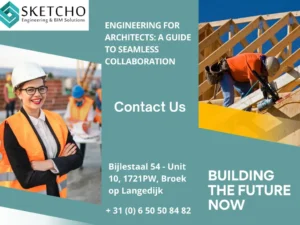Have you ever struggled to communicate a design vision to your team or clients? Architectural visualization is the key to overcoming these challenges. At Sketcho, we’ve been assisting AEC professionals across Europe, North America, and GCC countries for over a decade, providing high-quality engineering services at competitive rates. Our focus? Helping you execute crucial projects with ease and precision.
What is Architectural Visualization?
To kick things off, let’s define what architectural visualization is. In simple terms, it’s a way of creating images or animations that illustrate what a building or structure will look like before it’s actually built. Thanks to technology, this process allows architects, designers, and clients to see the potential end product in a very realistic way.
Why is it Important?
You might be wondering, why is architectural visualization so important? First off, it helps bridge the gap between imagination and reality. When you think about it, not everyone can look at blueprints or sketches and understand the final look of a project, right? This is where architectural visualization steps in, turning those flat, 2D plans into vibrant, 3D renderings.
According to a 2022 survey, over 70% of architects reported that clients had a clearer understanding of projects when they used architectural visualization. That’s a pretty significant number! It not only improves communication but also helps in making informed decisions early in the process.
How Does it Benefit Architects and Clients?
For architects, the benefits are immense. Firstly, it saves time and money. Think about it—making changes on a computer is way easier (and cheaper) than doing it during construction. Additionally, it enhances creativity. Architects can experiment with different designs, materials, and lighting conditions, which can be quite liberating.
From the client’s perspective, architectural visualization offers peace of mind. Imagine investing in a project without fully understanding what you’re going to get. That’s a little scary, isn’t it? With detailed visualizations, clients can see exactly what they’re paying for, reducing the chances of any unpleasant surprises later on.
Types of Architectural Visualization
Now, let’s talk about the different types of architectural visualization. The primary ones include 3D modeling, rendering, and animation. Each serves a unique purpose and can be used in various stages of design.
3D Modeling
3D modeling is the process of creating a three-dimensional digital representation of a structure. It’s like building a digital model of the project that you can view from any angle. Architects can add intricate details to these models, making them incredibly realistic.
Rendering
Once you have a 3D model, the next step is rendering. This is where the magic happens! Rendering transforms those models into high-quality images. It adds textures, lighting, and shadows, making the image look like a real-life photo.
Animation
Sometimes, images aren’t enough, and that’s where animation comes in. It allows viewers to walk through a space virtually, giving a much clearer sense of scale and flow. It’s especially useful for large projects or when showcasing interior designs.
Tools and Software For Architectural Visualization
There are many tools available for creating architectural visualization. Popular software includes Autodesk’s Revit, SketchUp, and Blender for modeling, while V-Ray and Lumion are favorites for rendering. Each tool has its strengths, so choosing the right one depends on the project needs.
The Future of Architectural Visualization
Looking forward, the future of architectural visualization is incredibly exciting! With advancements in technology, we’re seeing the rise of virtual reality (VR) and augmented reality (AR) in the field.
These technologies allow clients to immerse themselves in a project, walking through spaces as if they were physically there. The architectural visualization market is expected to grow, driven by these innovations.
Challenges and Solutions
Of course, like any field, architectural visualization has its challenges. The biggest one is the learning curve associated with mastering the software. It requires both technical skills and an artistic eye. However, many resources and tutorials are available online to help beginners get started.
Another challenge is keeping up with rapidly changing technology. The key is continuous learning and adapting to new tools as they emerge. Joining online communities and forums can be a great way to stay updated and share knowledge.
Our Tailored Solutions For Architectural Visualization
Sketcho offers a range of solutions designed to meet the unique needs of each project. Our precision 3D modeling ensures accurate project depiction, making construction more efficient and design visualization more effective. Plus, our expert consultation and support throughout the BIM lifecycle enhance project collaboration and efficiency.
Our services include:
- Tailored engineering solutions for optimized performance and efficiency
- Precision 3D modeling for enhanced design visualization
- Expert consultation and support to improve project collaboration
- Cutting-edge technologies to stay ahead of industry standards
Conclusion
Architectural visualization is a game-changer in the world of design and architecture. It’s a tool that transforms abstract concepts into tangible, visual experiences, benefiting both architects and clients. With the ever-evolving landscape of technology, the possibilities are endless. Whether you’re an architect or a client, understanding architectural visualization can make a world of difference in the success of a project.
So, next time you hear about a new building project, remember the role architectural visualization plays in bringing those blueprints to life.
Moreover, Sketcho is here to make your vision a reality. By working with us, you can expect improved project quality, reduced risks, and faster completion times. Plus, you get to collaborate with a team dedicated to excellence.





